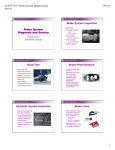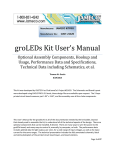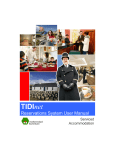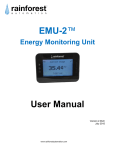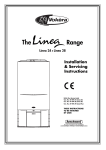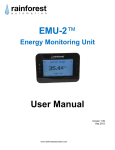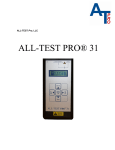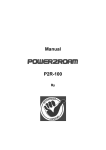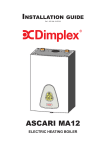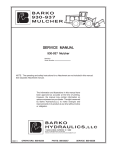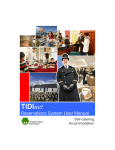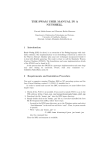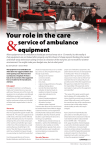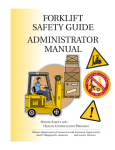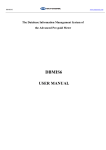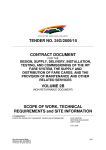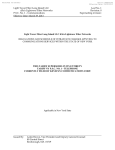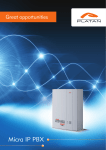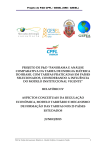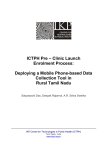Download Terms of Reference 15_ 01 _08 - Back
Transcript
Demand Side Management Solar Water Heating Residential Incentive Programme ACCREDITED PARTICIPATING SUPPLIER TERMS OF REFERENCE DOCUMENT NUMBER: TOR1 Page 1 of 30 SWH Terms of Reference 1 Introduction 3 2 Glossary 3 3 Programme purpose and description 5 4 How to Become a Accredited Participating Supplier 6 5 Approval and Registration of SWH systems 8 6 Installation Procedures 9 7 Relation between Accredited Participating Supplier and Customer 10 8 The Sale and the Paper Trail 11 9 Facilitating Auditors Role 12 10 Programme Duration and Due Changes 12 11 Safe disposal and destroying of electric geysers 13 12 Terms of Programme on Exclusion & Deregistration 13 13 Penalties for non conformance 13 14 Customer restrictions 14 15 Generic communications 14 16 Technical Auditor Function 14 17 Review Board 14 18 Eskom Call Centre Function 15 19 Ombudsman Function 15 20 Contact Details 15 21 APPENDICES 16 Page 2 of 30 SWH Terms of Reference 1 Introduction Eskom, in line with government objectives to diversify a percentage of energy to renewable sources and due to generation constraints, is launching a Solar Water Heating (SWH) Incentive Programme. The programme will consist of an incentive offered via the Participation Supplier in order to reduce the cost of a SWH system to the Customer. In order for the supplier to take part in the incentive programme the organisation will need to adhere to certain stipulations set out by the programme. It is foreseen that there will be many benefits to be gained from this programme, to name a few; suppliers should see a notable increase in sales, Eskom should see a reduction in peak demand and electrical use, Customers should see a reduction in electricity bills and the environment should gain in terms of emission reductions. The programme is intended to run for a period of at least five years, completing in 2013. However, through ongoing performance monitoring programme improvements and changes are expected. 2 2.1 Glossary Programme Terms ‘Customer’ means, the members of public purchasing an Installed Registered SWH system/s from a Participating Supplier within South Africa. ‘Demand Side Management’ or DSM is a utility program aimed at optimizing consumer use of energy through load shifting, conservation or efficiency measures. In South Africa the DSM programme is implemented by Eskom under the auspices of the National Energy Regulator of South Africa (NERSA). ‘Electrical or electricity’ energy that is derived from generated grid electricity whether from coal or other source. ‘Electrical Certificate of Compliance (CoC)’, an electrical CoC is required to be issued by a licensed electrician for any completed or partially completed electrical installations as per the Occupational Health and Safety Act (OHSACT) and Department of Labour. ‘Faulty’, is when the SWH system is not working as specified on the suppliers maintenance manual and as in accordance with specifications as passed with a valid Test Certificate or Mark Approval at SABS. ‘Guarantee’, is the supplier’s assurance of his system’s quality and performance. A Participating Supplier’s guarantee will state the terms and conditions under which his system can be returned, replaced or repaired and will need to be equal or better than the programme required levels. ‘Individual component guarantee’, parts of SWH systems can have guarantees of various lengths. These must be stipulated in the suppliers own terms to be given to the Customer. ‘Grace period’, is the period from time of issue that the Registered Suppliers will have to convert from a SABS Test Report for systems to SABS Mark Approval. ‘Granted’ means, incentives claimed that have been certified by the Eskom appointed facilitating auditors and will be paid into the supplier designated bank account. ‘Incentive’ means, amount in South African Rands to be Granted to Customer/s towards the purchase of a Registered SWH. Incentive value to be calculated using the Eskom formula found on www.eskomdsm.co.za. Page 3 of 30 SWH Terms of Reference ‘Installer’ means, the person/s doing a SWH installation under supervision of a Registered Installer. ‘Installed’, a Registered SWH system that has been supplied, correctly mounted, connected, tested and with a valid electrical CoC then found to be operating correctly at a Customers premises. ‘Installed cost’, means, the overall cost of the system including the cost of the purchased Registered SWH system, all pipes, valves and ancillary equipment and the cost of labour to install it in the Customers premises in a working order. ‘Life expectancy’, the predicted life span of the SWH system before requiring replacement. ‘Participating Supplier/s’, are defined as any participant who registers and is cleared by the Eskom programme facilitating auditors to sell Registered Solar Water Heating systems (SWH) to Customers with an associated incentive discount. ‘Registered Installer’, a SWH installer nominated by the Participating Supplier (interim arrangement) who can sign off on a SWH installation on behalf of the Participating Supplier/s. (Once formal accreditation is in place Participating Suppliers will be notified and will need to make use of CETA certified Installers and Registered Installers. A grace period will be given for Participating Suppliers to comply). ‘Registered SWH/’s’, a SWH system that has been registered for participation in the Eskom SWH programme by having obtained a valid SABS Test Report or having obtained the SABS Mark Approval. ‘Residential’, household establishment/s that consume energy primarily for space heating, water heating, air conditioning, lighting, refrigeration and cooking. This will not exclude household establishments that serve this purpose for financial means e.g. guesthouses. This does not include commercial tanks, those that are larger than 350litres. ‘SABS Test Report’, relates only to the specific sample/s tested as identified therein, it does not imply SABS approval of the quality or/and performance of the item/s in question and the test results do not apply to any similar item that has not being tested. ‘SABS product certification mark approval (referred to as ‘SABS Mark Approval’)’, is a voluntary scheme that entails a test report to be submitted to the approvals board and an audit of the applicant factory and manufacturing quality system, eg ISO 9001. ‘SWH system’ means, a water heating system that uses solar energy to generate hot water. The various types of configurations that will be accepted are described in the Configuration list. ‘Valid’, is within its expiry date, such as a SABS Test certificate is only valid for a period of one year. 2.2 SWH System technical terms ‘Absorber’, the component of a Collector that absorbs solar heat energy and transfers it to the water either in the Collector or in the storage vessel. ‘Close coupled system’, means, a SWH system where the tank and the heat collectors are located directly next to each other, with the tank always being situated above the collector/s. ‘Collector’, the unit that contains the Absorber/’s, can be a flat plate, heat pipe or evacuated tube collector. ‘Direct system’, means, water is heated in the SWH collector and this hot water is transferred directly into the tank. An Eskom Holdings Limited (Pty) Ltd document Page 4 of 30 SWH Terms of Reference ‘Electric geyser’ refers to a conventional water heater (geyser) that is not specifically designed for Solar Water heating purposes. ‘Evacuated tube system’, a Collector where the Absorber is contained within a series of glass tubes. ‘Expansion tank’, water tank that takes up the overflow created when the heat transfer fluid in an ‘Indirect System’ expands. ‘Flat plate system’, a Collector where the Absorber is contained within an insulated box, covered by toughened glass. ‘Freeze resistant’, means, a system that has passed the SABS freeze test and can be used in areas known to have frost. ‘Heat exchanger’, a substance or material such as copper with good conducting capabilities and approved by SABS that absorbs heat and then transfers the acquired heat from itself to the water, or heat exchange fluid through a separating wall. ‘Heat exchange fluid’, a fluid that is passed through a heat exchanger and is circulated within the heat exchange system to prevent freezing or corrosion. ‘Heat pipe’, a Collector where the Absorber is contained within a series of glass tubes. ‘High pressure’, any SABS certified/approved system that operates above 100kPa and works in conjunction with a pressure valve. ‘Indirect system’, solar water heating system in which an absorber transfers heat via a heat exchanger to the water to be heated ‘Low pressure’, any SWH system that operates below 100kPa. ‘Pumped’, a SWH that uses a pump to circulate the water. ‘Split system’, a SWH system where the tank and the collector are separated from each other. ‘SWH vessel’ means, a water tank that is suitable to work with the other aspects of a said SWH system, the tank must be SABS approved and have been tested with the rest of the system being sold to the customer as a unit. ‘Thermosiphon’, means, water circulates through the system due to natural processes of warm water rising and cold water sinking and no external pump system with an energy source is required. ‘Timer’, a device fitted to a SWH to control when a heating element may or may not be switched on and for the purpose of the programme complies with the minimum specifications stipulated (refer Timer specifications). 3 Programme purpose and description This is an Eskom Demand Side Management (DSM) programme whereby a monetary incentive based on the below standard calculation shall be provided to Customer’s in line with the purchase and installation of Registered SWH systems via Accredited Participating Suppliers. The incentive value shall be calculated according to a formula (provided below) relating to the efficiency of the Registered SWH system as determined by the SABS test output and hence the amount of energy displaced. A modifier for local content is also included in the incentive calculation (shown below) to promote both longevity of SWH systems and stimulation of the local economy. Page 5 of 30 SWH Terms of Reference This modifier will however remain ‘1’ for the first year of operation after which it will be phased in appropriately. Q, the system rating determined by SABS for a standard day in kWh; fLC, a modifier for Local Content that can increase or reduce the incentive by up to 5%; Details of the modifiers will be finalised and agreed in the first year of operation with input from the Advisory Board and phased in as appropriate. The programme is open for SWH Suppliers that meet the following requirements: Suppliers that have a valid SABS Test Report (limited to 18 months from date of first test report) or a valid SABS Mark Approval. Suppliers that have been Registered and then accredited by the appointed facilitating auditors. Member of Sustainable Energy Society of South Africa – Solar Water Heating Division -SESSA SWHD The programme will be open for Registration in December 2007 and Registered Systems sold by Accredited Participating Suppliers and installed by Registered Installers will qualify for the incentive once the programme is launched. Only sales transactions concluded on or after the date suppliers become Accredited Participating Suppliers will be eligible for the Incentive. The intent is for the programme to operate for a period of five years; however Eskom reserves the right to terminate, modify and/or extend the programme. The introduction of this programme in no way impinges on Eskom’s right to launch other SWH programmes of a different nature. 4 How to Become a Accredited Participating Supplier Suppliers who wish to participate in the scheme need to complete the attached application form and mail, hand deliver or courier the original copies together with all relevant information to the Facilitating Auditor. (Faxed or e-mailed copies will not be accepted as originals will be required). This must be submitted as soon as possible to facilitate the accreditation process. Participation by suppliers in the program will be effective only after the supplier’s application has satisfied all the criteria for accreditation and the supplier has been accredited as an Accredited Participating Supplier and has received a Certificate of Accreditation and the applicable incentive value for each system registered has been calculated and advised. Please note that a single application may be submitted to register a Supplier for Accreditation and to register their associated Installer/s and Products by submitting completed documents as per Appendix A, B and C. However SWH systems and Registered Installers may be added to the programme by submission of only relevant sections of Appendices B or C, as applicable during the course of the programme. The supplier will register their intent to participate and upon confirmation that they have been accredited, an Accredited Participating Supplier will be issued a Unique Accredited Participating Supplier Number and an official Accreditation Certificate, by the Facilitating Auditor. 4.1 Terms of Registration Process to follow in order to register as an Accredited Participating Supplier: 1 The offer is open to all SWH suppliers, who register and meet the set criteria outlined in this document and then are accredited as an Accredited Participating Supplier. . Page 6 of 30 SWH Terms of Reference 2 Accredited Participating Suppliers who were previously expelled from the programme may not re-register. Nor may they register under any different manner or form whatsoever. 3 Suppliers wanting to participate in the programme will need to register for accreditation as an Accredited Participating Supplier by completing and submitting the attached application form and submitting it to the Facilitating Auditors, with all the relevant information as set out in the document. 4 The appointed Facilitating Auditors must be provided with the information and documents as set out in 4.2 below and they will check the following key criteria as part of the accreditation process: Valid SABS approved systems Tax and registration legalities The ability of the business to continue service to customers and uphold the system Guarantees by the appointed facilitating auditing team. 5 Suppliers will be notified via the appointed facilitating auditors whether they have been successfully accredited as Accredited Participating Suppliers in the programme. 6 Suppliers may lodge their registration with the Facilitating Auditors before completing their SABS testing; however they may only be Accredited and therefore be able to sell incentivised systems once they have a valid Accreditation Certificate and bar codes issued by the Eskom Facilitating Auditors. 7 Accredited Participating Suppliers will need to be registered members of the SESSA SWH division. 8 Notification of Accreditation will include confirmation of the calculated incentive for the Registered Systems. 9 Eskom Demand Side Management will fund up to 50% of energy efficient measures. Therefore if the applied calculated system rating results in an amount higher than 50% of the installed system cost then Eskom will only pay 50% of that cost as mandated by NERSA. 10 Accredited Participating Supplier’s choice of system to be included in the programme is solely at their discretion, based on their own perceived market penetration. 4.2 Documents to be submitted to facilitating auditors 1 Company profile 2 Installation training manual 3 Tax Clearance certificate, recently dated 4 Copy of Company registration documents 5 Audited financial statements for the past 3 years 6 Copy of ID documents of shareholders or directors 7 Copy of Public liability insurance 8 Copy of guarantee structure 9 Copy of maintenance plan 10 Copy of SESSA membership registration 11 Copy of SABS conformity certificate and valid Test Certificate or Mark Approval 12 Proof of bank account in the form of cancelled cheque or stamped letter from the bank 13 Copy of Letter of Good standing from the Workman’s compensation 14 Three legitimate trade references 15 Three legitimate customer references An Eskom Holdings Limited (Pty) Ltd document Page 7 of 30 SWH Terms of Reference 5 Approval and Registration of SWH systems SWH systems registered by the Accredited Participating Supplier must comply with the following non-negotiable factors to qualify for an incentive: 1 SWH Suppliers will be considered for the Eskom incentive if, and only if they are selling systems with a valid SABS test report for the grace period only (as defined in 5.2 below) or systems that have obtained the SABS Mark Approval. 2 A grace period of 18 months from date of obtaining first SABS Test Report shall be given for Registered SWH systems to obtain the SABS Mark Approval. 3 Once the grace period (as defined in 5.2 above) has expired the Registered SWH system and the Accredited Participating Supplier (if applicable to all Registered Systems for the specific supplier) that have not yet acquired the SABS Mark Approval will no longer be allowed to participate in the programme until such time that a valid SABS Mark Approval is obtained. 4 Accredited Participating Suppliers and Systems must comply with the following non-negotiable South African National Standards (SANS) for thermal & mechanical system performance and installation conformance: # 1 2 3 4 5 SANS Number Description/ Title SANS 1307:2005 Residential solar water heaters (SABS 1307) SANS 6210:1992 Residential solar water heaters - Mechanical qualification (SABS SM 1210) tests Residential solar water heaters Part 1: Thermal SANS 6211-1: (or part 2) performance using an outdoor test method (part 2 is an 2003 indoor test method) Safety of household and similar electrical appliances SANS 60335-2:2000 Safety Part 1: General requirements SANS 151: 2002 Fixed Electrical storage water heaters 5 The technology must consist of a high pressure system, operating at a working pressure of no less than 100kPa, with an insulated storage vessel. 6 The piping insulation must have an R value of no less than 1.0. 7 The system must either be installed without an electrical back-up and no provision made on the tank for electrical back up OR with an approved (according to Eskom specification) load management device such as a timer. 8 If a SWH system without electrical backup passes the SABS testing and is a Registered SWH system, then at no time during the programme may the Registered SWH system be fitted or used in conjunction with any sort of electrical back up; unless the SWH system is retested and reregistered as such. 9 Only SABS confirmed freeze-tolerant systems shall be registered as such. 10 Non freeze tolerant systems may not be installed in areas that are known to be susceptible to frost (any area where the air temperature drops below 4 degree C). If non freeze-tolerant systems are installed in areas that are known to have frost then the incentive will not apply. 11 The Participating Supplier is directly liable for any damages and shall be required to repair any system due to the installation of non-frost resistant Registered SWH systems in frost areas. 12 All Registered SWH Systems must be offered with a minimum comprehensive Guarantee of 5 years. 13 Electrical elements that are used in the programme may not exceed a power rating of 2kW’s. An Eskom Holdings Limited (Pty) Ltd document Page 8 of 30 SWH Terms of Reference 14 If a system is installed in a pre-feed / heat configuration the installation must adhere to the following conditions: A geyser blanket must be fitted to the existing electrical geyser and have a minimum R value of 1.0; Minimum R value for pipe lagging must be 1.0; Customer must be informed of warranty of electric geyser; SWH tank must not have an electrical element; The electric geyser must be fitted with a timer; and The electrical element in the electrical geyser (if used in pre feed/heat configuration) may not exceed a power rating of 2kW’s. Should the element in the electrical geyser have a power rating of more than 2kW’s, the element should be replaced with an element that does not exceed 2kW’s. 15 Pre-feed/heat systems will be allowed for a period of one year for evaluation and monitoring. Eskom holds the right to disallow types of system configurations at any point if it is deemed necessary. 16 Guarantees of installed but de-registered systems will remain valid and suppliers will remain responsible to honour these as per their standard Guarantee offering. 6 Installation Procedures The Accredited Participating Supplier will be the legally contracted entity for the programme and will remain responsible for their Installations. 1 Accredited Participating Suppliers remain responsible for installations of their Registered SWH systems. 2 Accredited Participating Suppliers will need to register their own Installers who will sign off on installed systems on their behalf (refer relevant Appendix C). 3 The Registered SWH system must be installed by a Registered Installer and the incentive will only be applicable once a Registered Installer has signed off the Installed System and a qualified electrician has issued a Certificate of Compliance upon inspection of the completed electrical installation. See Appendix F for more information on Electrical Certificates of Compliance. 4 Installations will need to be performed in accordance with the OSHACT (Occupational Health and Safety Act) and relevant National Standards such as the National Building Regulations and local by-laws where systems are installed. 5 Suppliers will be issued with unique sequenced numbered bar codes by the facilitating auditors: 5.1 Suppliers will be provided with sets of unique sequenced numbered bar codes in packs of 50 at a time. Suppliers will be required to sign for the bar code sets and to take responsibility for their safe keeping. Suppliers will need to apply for additional supplies of bar codes sets as required, in writing (by email will be accepted) 5.2 The bar codes will be issued in sets of 5 labels as follows: 2 metallic bar code labels 3 paper based self adhesive labels 5.3 The bar codes must be applied as follows in respect for each installation 1 metallic bar code to the solar collector 1 metallic bar code to the water storage vessel 1 self adhesive bar code to the electrical distribution board 1 self adhesive bar code to the Customer Information Form (Appendix D) 1 self adhesive bar code to the Eskom invoice claiming reimbursement of the incentive given on the installation 5.4 The bar codes will be used as a tracking and reference point for payment verification and technical audit check purposes An Eskom Holdings Limited (Pty) Ltd document Page 9 of 30 SWH Terms of Reference 6 Completed installation details and required forms and documents (as found in section 22 and 22.1) must be forwarded to the appointed facilitating auditors. 7 Technical auditing of installations will be performed on a continual basis and if Accredited Participating Suppliers are found to have installed systems that fail to meet minimum programme and operation specifications then Eskom reserves the right to remove the Accredited Participating Supplier from the programme if the faults are not fixed within 48hrs of notification at the expense of the Accredited Participating Supplier. 8 This section will be revised once formal Installation training is established resulting in a CETA certified SWH system installation qualification that will be necessary to partake in the programme. 7 Relation between Accredited Participating Supplier and Customer The relation between the Customer and the Accredited Participating Supplier follows all normal practices for a sale including that of a Registered SWH system. Eskom has no direct relation with the Customers except during monitoring and verification (M&V). The Accredited Participating Supplier will be fully responsible for the sale and all aspects relating to it. Customers are free to purchase from any Accredited Participating Supplier. Eskom will provide contact details of the Accredited Participating Suppliers, information surrounding the incentive and the programme and try to educate the Customer to make an informed choice. 1 From the programme start date, the Accredited Participating Suppliers will be able to make use of the full Incentive to offer an incentivised rate on a Registered SWH system against the purchase of a new SWH system. 2 All supply and installation costs are for the expense of the Accredited Participating Supplier/ Registered Installer. (to be agreed upon between these two parties). 3 The onus is on the Accredited Participating Supplier to liaise with the Customer as to the suitability of different SWH systems in conjunction with the Residential Customers home/business and/or individual needs. 4 The Accredited Participating Supplier must advise the Customer about the safest and most efficient use of the appliance on completion of the installation. 5 If issues arise and it is found that the Accredited Participating Supplier did not provide the customer with the appropriate knowledge, the Accredited Participating Supplier will be liable for any damages or savings accrued that are lost. 6 All pre and post implementation servicing of installed Registered SWH Systems remain the onus of the Accredited Participating Suppliers as per normal sale and after sale service requirements and is under no circumstances the responsibility of Eskom. 7 All maintenance and servicing of a system or issues arising thereof will be between the Customer and the Accredited Participating Supplier of that specific Registered SWH system and Eskom will not be held responsible in any way for this maintenance / services or cost thereof. 8 If the SWH system is proved to be faulty the Accredited Participating Supplier of that specific system will be liable according to the applicable Guarantees. Note: Participating Supplier has to provide the customer with a guarantee certificate. 9 If Accredited Participating Suppliers are no longer part of the Eskom programme for what ever reason, this will not be seen as an exemption from honouring Guarantees with Customers. 10 Should the Customer wish to purchase a system from a Supplier that has not as yet been tested and certified by SABS this is their choice. However they will then not qualify for the Incentive, nor shall Eskom reimburse the Customer should the system become available for Incentive at a later stage. An Eskom Holdings Limited (Pty) Ltd document Page 10 of 30 SWH Terms of Reference 8 The Sale and the Paper Trail The sale to the customer should be treated as a ‘normal sale’ with the exception of the incentivised price and the documentation that should accompany the incentive claim as listed below in sub-section (8.1.) 1 Only once the auditors have verified the Installed Registered SWH System is correct in terms of the guidelines set out in sub-section 6 can the full Eskom Incentive be granted to the Accredited Participating Supplier. Accredited suppliers will be notified in writing of the maximum incentive value determined for each system. 2 Incentive amounts claimed, must equal the incentive calculated by the facilitating auditors for the registered systems. 3 Accredited Participating Suppliers found to be fraudulently adjusting or claiming incentive amounts will be excluded from the programme permanently. 8.1 1 Documenting the Sale Accredited Participating Suppliers will need to retain the following customer information for every Registered SWH System sold that qualifies for an Incentive: a. Information in support of claim – Appendix E b. Copy of Customers ID book. c. Copy of Customers municipal rates and electricity bill or other proof of address. d. Copy of the customer invoice detailing all aspects of the transaction, Registered SWH system price and model number, Eskom Incentive amount given and net amount payable by the customer, other services provided etc. One copy of the barcode needs to be attached on the front of this invoice. e. Copy of completed claim and customer installation form Appendix D. f. Copy of electrical CoC for the SWH installation 2 Forms that are not completed and signed by all relevant parties as prescribed will not be processed. 3 A valid VAT invoice to Eskom Holdings Limited per incentive claimed from Eskom, including a summary of the installation which reflects full details of the completed transaction, including the system and customer details. This VAT invoice should be submitted to the facilitating auditors within two weeks of a completed Installed system. One copy of the barcode needs to be attached to the VAT invoice. The VAT invoice needs to be made out to: Company: Address: Description Eskom VAT number 4 Eskom Holdings Limited PO Box 15069, Ashwood, 3605 Incentive – SWH Programme 4740101508 All supporting documents (specified in point 1 above) must be submitted to the facilitating auditors with the incentive VAT invoice neatly prepared. The submission to the facilitating auditors will therefore consist of a VAT invoice to Eskom Holdings Limited supported by copies of all supporting documents as described above, per individual claim/installation. Where more than one incentive is claimed per submission, please provide a summary sheet showing incentive invoice numbers, amounts and the total of the submission for all the individual VAT invoices. The claims with all the supporting documentation must be send to the following address: Eskom SWH Project PO Box 578 Cape Town 8000 An Eskom Holdings Limited (Pty) Ltd document Page 11 of 30 SWH Terms of Reference 5 The Customer Information Form (Appendix D) and the Eskom invoice claiming reimbursement must have the self adhesive bar code attached (as set out in Section 6 above) 6 Accredited Participating Suppliers are required to keep copies of all documentation submitted to the appointed auditors for their own record and auditing purposes. 7 The onus is on the Accredited Participating Supplier and the Registered Installer to liaise with the customer in order to have these documents available before submitting to the facilitating auditors. 9 Facilitating Auditors Role The operational management and the application of this Terms of Reference for the programme will be undertaken by the Eskom appointed facilitating auditors. The appointed facilitating auditors are fully authorised to act as Eskom’s agents for the outputs detailed below. 1 Payments will be processed within two weeks from receipt of a complete invoice accompanied with all the supporting documentation as described in 8.1 above. Payments will be made to claimants every two weeks after completed claims are received provided that: The Installed Registered SWH system incentive matches the correctly calculated incentive price; Via the completed and signed customer installation form the Accredited Participating Supplier Guarantees the supplied system was properly and correctly installed; and The SWH system is a Registered SWH and has a valid SABS test report or Mark Approval as applicable. 2 Only once all the stated conditions are met and the facilitating auditor validates the installations, will the relevant funds be transferred into the Accredited Participating Suppliers bank account. 3 A reconciliation reflecting the amounts paid to each individual Accredited Participating Supplier will be prepared and this will reflect the list of invoices for which payment was granted. 4 Random telephonic checks to verify the validity of the data provided, purchase and installation and its compliance to the set stipulations will be done by the appointed facilitating auditors. 5 Please note that processing of claims will not depend on, but all claims will be subject to the following: A sample of Installed SWH Systems will be selected by the appointed facilitating auditors and site visits will be undertaken by Technical Auditors for Registered SWH system compliance and installation checks. Results of Technical and Telephonic Audits will inform the processing of future claims and continued participation by either Registered Installer or Accredited Participating Supplier as appropriate. The facilitating auditors retain the right to deduct incentives paid out from future claims, should the audits reveal that all requirements were not met. 10 Programme Duration and Due Changes 1 This programme will continue to run for a period of five years, from programme commencement date being 1 December 2007, with reviews and adjustments made during that period depending on market forces and the uptake of the incentive. Eskom reserves the right to reasonably modify the scheme from time to time. 2 Annual renewals of registration will be required by the Accredited Participating Suppliers (details to be provided in due course, but would typically include confirmation of validity of SABS test reports and salient facts). 3 Eskom reserve the right to discontinue or modify the programme in which case due notice of 3 months will be provided in writing to all participants. An Eskom Holdings Limited (Pty) Ltd document Page 12 of 30 SWH Terms of Reference 11 Safe disposal and destroying of electric geysers This programme will require the destruction of decommissioned electric geysers after a solar water heater system installation, if the system is not a pre-heat configuration. Accredited Participating Suppliers are to adhere to the stipulations set out below: 1 Once a Registered SWH system is installed the old electric geyser must have a hole drilled into the bottom of the geyser regardless of whether the old geyser will be removed or not. 2 If the old geyser is to be removed (after a hole has been drilled as described above) the old electric geyser must be completely removed from the customer’s roof. The wiring must be left in a condition in accordance with relevant regulations. 3 If the electrical geyser can not be removed from the premises due to structural aspects then the old electric geyser may be left, provided that a hole is drilled as described above. The wiring must be left in a condition in accordance with relevant regulations Please note that customers will be required to sign off whether a hole, as described, was drilled into the old electric geyser and as to whether the old geyser was removed or not on the form to be submitted to the facilitating auditors. 12 Terms of Programme on Exclusion & Deregistration Exclusion from registration for the Eskom programme will occur if; 1 SWH Systems do not have a valid SABS test report, SABS Mark Approval as appropriate. 2 Suppliers who are deemed by the appointed facilitating auditors to be financially at risk through participation or unable to uphold their Guarantees. 3 Suppliers that do not register with the SESSA SWH division. 4 The supplier has been expelled before. Expulsion/Deregistration from the programme will follow if any of the following occur: 1 Persistent or deliberate breach of programme rules. 2 Selling sub-standard systems that do not comply with the standards or equipment that was tested through the SABS. This will be identified via post installation on site technical auditors. 3 If Installed systems are repeatedly found to be faulty, this will be seen as non-compliance to SABS requirements and the supplied system could be removed from the programme completely or until such time as they comply with SABS requirements. 4 If more than 5 major complaints relating to one Accredited Participating Supplier are received they will be brought up in front of a review board and may be expelled from the programme. 5 Falsification of forms submitted to the appointed facilitating auditors 6 Fraudulent activity in relation to any aspect of supply or installation in terms of the above document. 7 If the supplier fails to obtain the SABS Mark Approval for a system within the 18 month period, commencing from the first SABS test report. 8 If any of the registration requirements, as set out by this document, are not adhered to anymore. 13 Penalties for non conformance 1 In the event that the Incentive requests made are found to be fraudulent a full forensic audit will be completed and defaulting Accredited Participating Suppliers will be liable to pay back Granted incentives for those fraudulent claims. 2 Accredited Participating Suppliers found to be fraudulently using the programme will be removed from the scheme. An Eskom Holdings Limited (Pty) Ltd document Page 13 of 30 SWH Terms of Reference 3 Accredited Participating Suppliers or Registered Installers found to be engaging in fraudulent activity in regards to the scheme could be prosecuted. 4 Any technical non conformance found will require correction by the Accredited Participating Supplier. The facilitating auditors will notify the Accredited Participating Supplier who will need to show proof of correction. 14 Customer restrictions 1 Incentives will not be granted to Registered SWH’s that are installed outside of South Africa’s borders. 2 Suppliers or Accredited Participating Suppliers that are found to provide falsified Registration forms will be viewed as defrauding the programme and could face legal prosecution. 15 Generic communications Eskom will develop and implement a supporting marketing, awareness and education campaign. Capacity will be developed in Eskom call centres to address general queries regarding the programme. This will include making available to Customers contact details of Accredited Participating Suppliers in the area of interest. 1 Accredited Participating Suppliers will have to develop their own marketing as they see fit. 2 Customers will need to contact Participating Suppliers directly in order to qualify for the incentive for a Registered SWH system. 3 Eskom will host the programme site and provide the programme details and Participating Supplier details including a brief description on Registered SWH systems to the Customers at www.eskomdsm.co.za. Example of data that will be published is attached as Appendix H. 4 If there are changes or updates to be made to the Accredited Participating Suppliers details the onus is on the Accredited Participating Supplier to ensure the appointed facilitating auditors receive these details and that the website is updated accordingly. 16 Technical Auditor Function 1 The Facilitating Auditors will select a statistically random sample of installations for technical audits as part of their programme facilitation. 2 Technical auditors will contact customers and arrange for appropriate on site inspections to conduct audits. Verifications on the installations will be carried out according to a standard checklist. 3 The technical auditors will submit reports to the Facilitating Auditors who will deal with the data accordingly. 17 Review Board The Review Board will serve as an advisory body that provides guidance to the SWH Programme and manage escalated issues and appeals. The body consists of representation from the following organisations: Central Energy Fund (CEF) Sustainable Energy Services South Africa (SESSA) National Energy Regulator South Africa (NERSA) Consumer Council / Watchdog Eskom Department of Minerals and Energy (DME) An Eskom Holdings Limited (Pty) Ltd document Page 14 of 30 SWH Terms of Reference 18 Eskom Call Centre Function The Eskom Call Centre’s operation will administer incoming calls from customers on Registered SWH system support and information inquiries. The call centre functions will be follows: Provide information on list of Accredited Participating Suppliers Log for calls from customers Check that customers have appealed to the Accredited Participating Supplier Redirect complaint calls to Facilitating Auditors Provide call log to Facilitating Auditors twice a month 19 Ombudsman Function In the event the disputes or issues that can not be resolved by existing processes Eskom will appoint an ombudsman. 20 Contact Details If there are any queries please feel free to contact the Facilitating Auditors, Deloitte & Touche for supplier participation on the SWH Programme Participation: Telephone Direct Fax e-mail (021) 670 1709 (021) 413 2833 [email protected] Postal address Eskom SWH Project PO Box 578 Cape Town 8000 Physical address 11 Lansdowne Road Claremont 7708 Premises where direct copies may be dropped off for submittal to the main branch: The Customer Service Helpdesk for customer enquiries are: Telephone e-mail (011) 800 4744 [email protected] An Eskom Holdings Limited (Pty) Ltd document Page 15 of 30 SWH Terms of Reference 21 APPENDICES 21.1 Appendix A. Supplier Registration form - Example Supplier Registration Information 1 Supplier Company Name 2 Contact name at head office Position held: 3 Physical address: Phone: Fax: E-mail: Please list the areas in which your company will be operating for this initiative and name the Regional Office/Representatives who will be dealing with the customers in that region. 4 Contact name at regional office Position held: Physical address: Ph: Fax: E-mail: 5 Contact name at regional office (2): Position held: Physical address: Ph: Fax: E-mail: If there are more than 2 regional offices, please add names on a separate page 6 Please identify the documentation attached as proof of the current Financial Status of the Company Tick 6.1 Current Tax Clearance certificates/ Copy of Current VAT certificate (where applicable) 6.2 Audited financial statements for past three years 6.3 Original cancelled cheque or stamped letter from the bank, verifying the banking details 6.4 Copy of Company Registration Documents 6.5 Copy of ID Documents of directors/owners/members/ shareholders 6.6 Copy of COID (Compensation for Occupational Injuries and Diseases) registration certificate e.g. Letter of Good standing 6.7 Copy of Public Liability Insurance 6.8 6.9 Copy Guarantee Structure & Copy of Maintenance Plan Proof of SESSA membership registration 6.10 Copy of company Profile (including but not limited to: years of experience in solar water heating, core business areas 6.11 Installation and training manual 6.12 Copy of three legitimate Trade references 6.13 Copy of three legitimate customer references 6.14 Copy of SABS conformity report, full test report and relevant test certificates 6.15 Copy of Mark Approval certificate if relevant 6.16 Proof of BEE status (if applicable) Page 16 of 30 SWH Terms of Reference 21.2 Appendix B: Product Registration Form - Example Product Information 1 Please provide information for the SWH systems that you want to register for the Eskom DSM SWH incentive programme. Please complete a separate form for every product/model you are registering. Cost information is indicative only and may be updated with the auditors as and when required. Please note that cost provided will be published as indicative retail prices on the SWH website. 1.1 1.2 Name of Model: Guarantee period for system: (Includes all components for comprehensive guarantee period) 1.3 Indicative retail price (uninstalled): 1.4 Indicative installation cost (please provide a typical range): 1.5 SABS allocated Q factor for standard day (as per test report): 1.6 SABS Mark Approval obtained: 1.7 SABS Mark Approval Expiry date: 1.8 SABS Test report 1.9 SABS Test report expiry date: Note that the following will be used as input for the Local Content and Guarantee analysis. The best possible indication of the following should therefore be provided. Note that the information provided will be correlated against a SABS assessment. Yes No SABS Mark Approval number Yes No SABS Test Certificate Number Component breakdown: 2 Component 2.1 2.2 2.3 2.4 2.5 2.6 2.7 2.8 Water tank: Collector: Valves: (temperature) Valves: (pressure) Piping: Pump: Timer: Other (please specify): Cost as a percentage of indicative retail price (point 1.3 above) An Eskom Holdings Limited (Pty) Ltd document Country of manufacture/ origin Guarantee period (years) SABS Approved Page 17 of 30 SWH Terms of Reference 3 Product specifications: 3.1 Does the system have electric back-up? 3.2 3.3 Type of panel: Number of tubes or risers: 3.4 Diameter of tubes (if vacuum type): Length of tubes: Element make and wattage: Geyser blanket: 3.5 3.6 3.7 3.8 3.9 Heat exchanger: (eg copper) Heat transfer: 3.10 3.11 3.12 3.13 Panel size (sq metres): Operating pressure (s): Panel aperture: Wattage of geyser element: 4 5 6 Yes No Do you normally do an installation in conjunction with a timer Tank/cylinder make: Tank material – Inner: Outer: Type of piping: Diameter of piping: Collector cover: Heat transfer fluid composition: Insulation: Direct / Indirect Circulation: Yes No Yes / No Active / Pumped Or Passive / Thermosiphon Volume (litres): Geyser set point: Geyser make: Heal Loss coefficient (W/K): Please indicate which of the following applies to this model by ticking the relevant box SANS 1307: 2005 SANS 6210: 1992 SANS 6211-1 / 2 SABS SABS SM 1210 2003 (SABS 1307) 2002 151: Please indicate/confirm that the following have been attached to this document for the relevant SWH system/model User manual with training, safety and Installation manual: optimal usage guidelines Maintenance and guarantee plan to be Other: provided to customer Please copy the table for each additional model/ product range An Eskom Holdings Limited (Pty) Ltd document Page 18 of 30 SWH Terms of Reference 21.3 1 1.1 Appendix C: Installer Registration Form - Example Installer Registration Information Please register SWH installers with their relevant details installation of SWH systems supplied by your company: Installer name: Company name and physical address: who you approve for sign-off authority on ID Number: Position held: Ph: Fax: E-mail: ID Number: Position held: Ph: Fax: E-mail: ID Number: Position held: Ph: Fax: E-mail: 1.2 Installer name: Company name and physical address: 1.3 Installer name: Company name and physical address: 2 Acknowledgement and Signature I acknowledge that participation in the Eskom DSM SWH programme may have the following requirements that I commit to comply with: • Information sharing relating to the programme as required by facilitating and technical auditors as well as Monitoring and Verification teams appointed by NERSA. • Full co-operation/participation in annual SWH sales survey conducted by an independent contractor committed to confidentiality and sharing of global data only. • Installation of SWH system with electrical timer compliant with specifications provided by Eskom DSM. The complete requirements as described in the Accredited Participating Supplier Terms of Reference and agree to be contractually bound to the stated requirements. Name of company representative: Signature Date: An Eskom Holdings Limited (Pty) Ltd document Page 19 of 30 SWH Terms of Reference 21.4 Appendix D: Customer Information - Example Part A: Information sourced from Customer 1. Name of Customer Name of Supplier: Supplier Registration number: Customer contact details: 2. Cell: Work: Physical address: Home: GPS Coordinates (if possible): Ph: Fax: e-mail: 3. Model purchased: Serial number of installed system: 4. Bar code Reference number: 5. Total number of persons living in household: Number of appliances utilising significant quantities of hot water: (i.e. washing machine, dishwasher or other) 6. Number of people at home during the day using hot water: Number of bathrooms drawing water from SWH: 7 The SWH geyser was installed in a pre-feed/heat configuration 8. My electric geyser was: (please tick valid box) Used in configuration a pre-feed/heat Removed from my roof and premises and destroyed: YES NO Destroyed, but left in my roof: Please indicate if the following information was supplied by you: 9. Copy of ID book Copy of municipal or electricity account as proof of residence 10. Copies of the electrical certificate of compliance issued after the completion of the installation. 11. I, the customer, hereby declare that all the information I have provided above is correct and complete, and provided of my own free will: YES NO 12. I, the customer, hereby declare that I have received a guarantee certificate and conditions of the guarantee: YES NO 13. I, the customer, hereby declare that I have received a Eskom SWH programme brochure and I understand the contents thereof: YES NO 14. I, the customer, hereby declare that the installer has explained all aspects of my installed SWH system and its correct usage and has provided me with an Operations and Maintenance Manual: YES NO 15. I, the customer, hereby declare that if my electrical geyser has not been used in a pre-feed/heat configuration, it has been either removed and destroyed or destroyed and left in my roof. I am aware that if it is found to be still in a working condition I am liable to pay back the full amount of the incentive. YES NO Page 20 of 30 SWH Terms of Reference 16. Were any additional South African subsidies or incentives applied with this sale? 17. Tick the payment/funding option used: Cash payment Monthly hot water bill YES Monthly hot water bill NO Other (specify) PART B: Acknowledgement and Signature 1 I acknowledge that participation in the Eskom DSM SWH programme may have the following requirements that I commit to comply with: Information sharing relating to the programme as required by facilitating and technical auditors as well as Monitoring and Verification teams appointed by NERSA. I have been informed that I may receive a phone call to verify the installation of my SWH and I agree to allow a technical audit team on site if requested. I agree to allow a Measurement and Verification team onto my property to install a data logging system to validate energy savings (this system will not affect the SWH or electricity usage) Full co-operation/participation in annual SWH sales survey conducted by an independent contractor committed to confidentiality and sharing of global data only. Installation of SWH system with electrical timer compliant with specifications provided by Eskom DSM. Name: Signature: Date: An Eskom Holdings Limited (Pty) Ltd document Page 21 of 30 SWH Terms of Reference 21.4 Appendix E: Information to support claim for reimbursement of incentive - Example PART A. Supplier Information Supplier Name Accreditation Number Supplier Invoice (addressed to Eskom) attached Invoice # YES Invoice Date NO Invoice Amount PART B. Information about Installation 1 Name of Customer Name of Installer: 2 Model installed: Serial number system: 3 Orientation of solar collector: Percentage of shade collector exposed to during the day: 4 Does the hot water supply chain have an electrical element after installation: If yes: is the element in the electrical geyser or the solar geyser: 5 What size is the electrical element: Size and configuration system replaced: 6 Total number of persons living in household: Number of appliances utilising significant quantities of hot water: (eg: washing machine, of installed dishwasher or other) 7 Number of people at home during the day using hot water: Number of bathrooms drawing water from SWH: Please indicate if the following information is attached to this form: 8 Copy of customer ID book Copy of municipal or electricity account as proof of residence 9 Copy of a detailed signed invoice Copies of the electrical certificate of compliance issued after the completion of the installation. 10 Customer information form completed and signed by customer 11 I, the registered installer, hereby declare that all the information I have provided above is correct and complete, and provided of my own free will: YES NO 12 I, the registered installer , hereby declare that I have completed the installation as per all relevant South African standards and those required by Eskom: YES NO PART C: Acknowledgement and Signature I, the registered installer, hereby declare that the above installation has been completed at the stated address and that the system/s appears to be fully operational and that I have completed the installation at the above address in accordance with all relevant installation standards (OSHACT) and product specific specifications. Name: Signature: Date: Page 22 of 30 SWH Terms of Reference 21.6 Appendix F: Electrical Certificate of Compliance Since 1992 Electrical Certificates of Compliance have been a legal requirement for houses and new electrical installations in houses. If a premises already has a valid CoC, then only a “partial” CoC will be required that will cover the new installation. The details of an Electrical Certificate of Compliance are found in the Department of Labours document, Electrical Installation Regulations. Suppliers should visit the Department of Labour’s website or alternatively contact them directly should you the wish to enquire about these regulations. 21.7 Appendix G. Timer Specifications 21.7.1 Objective Broad specifications for the electronic timing unit installed with the Eskom Solar Water Heater project. The function of the timer will be to ensure that the hot water element is switched “off” during predefined time periods. The function of the timer in the Solar Water heating installation is two-fold Energy savings by avoiding unnecessary electricity use To ensure a peak demand savings in the Eskom peak hours An added advantage is the “override” function that the unit provides. In normal Hot Water control projects the system is controlled from a central point and the customer cannot influence the switching algorithm. With the timer and its override function the customer has a more flexible way to participate and still obtain energy savings. 21.7.2 Installation The timing unit will be installed in series with the normal geyser circuit breaker. The timing device’s function will be to switch the element on and off during normal operating conditions. The function of the normal circuit breaker will be to protect the circuit against short circuit conditions. The figure below shows the timer position in the installation. The timer therefore does not make the circuit breaker obsolete in the installation. It is essential to understand that the normal circuit breakers function is that of protection of the circuit against over current and the function of the timer to switch the element on and off during normal conditions. CB Elem ent Elem ent CB T im er Timer installation position 21.7.3 General specification In the South Africa, circuit breakers of the class found in domestic installations have to conform to the SANS 156 specification. This specification is derived from the IEC 60947-3 specification. The SANS 156 covers single-pole and multi-pole air-breakers, assembled as an integral unit in a supporting and enclosing moulded case of insulating materials, for current rating up to and including 1 000 A and for alternating voltages up to and including 660 V and direct voltages up to and including 500 V. The normal circuit breaker in the installation has to conform to this standard. 21.7.4 Certificate of compliance (COC) It is required by law that each electrical installation be signed off by a duly authorised person. This includes installations that have a valid COC and has recently been worked on. In the case of the timer installation it follows that a new COC will have to be issued to ensure compliance. In this case this person will have to be a qualified electrician with a wireman’s license. An Eskom Holdings Limited (Pty) Ltd document Page 23 of 30 SWH Terms of Reference 21.7.5 Broad timer specifications DIN and MINI rail mountable if space available in household Distribution Board Surface mountable with 2 by 4 box - earthed or double insulated Battery backup of at least 5 year shelf live Timing unit o Digital clock with own oscillator, o Limits drift to 1% per year, with optional 50 Hz checksum. o LCD or LED low power display, o User programmable timer setting with non-volatile memory to ensure un-interrupted operation. o Optional weekend mode as household patterns change over weekends. o Include Away mode. A manual override function to switch the timer by hand at any time At least 3 programmable “on” and “off” cycles to be available per day E.g. needs to be able to switch on and off at least three times a day Mode to support a daily repeat of the set “on”, “off” cycles. E.g. needs to repeat the above setting every day into the future Resistive switching capacity of 5kW/21 Amperes or 3KW/16Amperes Rated voltage : 230/240V Rated frequency : 50 HZ Sustain fault of 2.5kA for 10milli seconds without destructing Do not operate under fault conditions. Power consumption : 1VA LED to indicate normal mode and override mode Where switching noise might prove to be a problem, consideration must be given to use Solid State Relays were applicable. Operations at full load (4 per day, 10 years) = minimum of 14,500 operations Timing control unit to be covered by a protective cover to avoid tampering or accidental changes to timing algorithm Clear and easy to use instruction pamphlet to accompany each unit Operating temperature : -20 to 55 degrees centigrade, although +70 degrees centigrade will ensure longer life Dirt and moisture protection : IP65 21.7.6 Other considerations Ensure that a highly visible sticker is left on DB with following information o Where to get help o Timer settings o Reminder about this being part of an energy savings initiative o How to override Consider additional signage outside gate of residence to indicate that the household is energy conscious, and using solar energy as an alternative energy source. An Eskom Holdings Limited (Pty) Ltd document Page 24 of 30 SWH Terms of Reference 21.8 Appendix H: Example Published Details of participating Systems Participating Contact Supplier Details Active areas Registered System Indicative retail price Expected range System efficiency Qualifying of installation rating (Q factor) incentive charge SABS Mark Approval Other Certifications Supplier A Joe Soap Gauteng R18,500 R1,500 R7,500 – 4.5kWh R2,250 Yes (ref #) Tel: Eastern Cape Applicable International certification Email address: Northern Cape EXAMPLE: 150L 2m2 EVT XXX System (as per SABS description) EXAMPLE: 200L 2m2 EVT XXX System (as per SABS description) EXAMPLE: 180L 2m2 EVT XXX System (as per SABS description) EXAMPLE: 300L 2m2 EVT XXX System (as per SABS description) EXAMPLE: 300L 4m2 flat plate XXX System (as per SABS description) R22,000 R1,500 R7,500 – 10kWh R5,000 Yes (ref #) Applicable International certification R15,500 R6,500 R7,500 – 6kWh R3,000 No Applicable International certification R20,000 R6,500 R7,500 – 12kWh R6,000 No Applicable International certification R21,000 R5,500 R7,500 – 11kWh R5,500 No Applicable international Certification Website link Supplier B John Doe Gauteng Tel: Kwa-Zulu Natal Email address: Website link Page 25 of 30 SWH Terms of Reference 21.9 Appendix I: Pictorial Glossary of System Configurations Solar Water Heater Configurations Selection The following table contains terminology and description for SWH System configurations as understood and used for this incentive programme. The status of acceptance into the incentive programme of the respective configurations is also indicated. A tick indicates acceptance, a cross indicates exclusion. Please note that all configurations still include programme requirements and all SABS requirements as per normal standards even though valves, etc, are not illustrated. Please note all configurations still include programme requirements and all SABS requirements as per normal standards even though valves etc are not illustrated. Pre-feed/heat geysers may only be installed in the Eskom programme under the following conditions: 1. Minimum R for geyser blanket to be added to the electric geyser must be 1.0 2. Minimum R value for pipe lagging must be 1.0 3. Customer must be informed of warranty of electric geyser 4. SWH tank must not have an element 5. Electric geyser must be fitted with a timer Key Solar Water Symbol Heater Component Notes Solar Water Symbol Heater Component Solar Collector Flat plate or evacuated tube Water flow and (Red indicates temperature hot water and indication blue cold water) Pump Used for forced Water flow and circulation of temperature water indication Conventional Water Heater (Geyser) Blue geyser indicates a SABS electric geyser. Water flow and temperature (Not indication specifically designed for Solar Water Heating) Direct water heating Solar water Indirect water heater for a heating direct system Notes Blue line indicates cold water Red line indicates hot water Orange line indicates heat transfer fluid Solar water heater for a indirect system Page 26 of 30 SWH Terms of Reference Description 1. Example Diagram Status √ Close-coupled, thermosiphon system. Collector and tank on the roof. Includes direct and indirect applications. Or 2. √ Split, thermosiphon system. Tank in the roof in close proximity, but above the collector. Includes direct and indirect applications. Or An Eskom Holdings Limited (Pty) Ltd document Page 27 of 30 SWH Terms of Reference Description 3. Example Diagram Status √ Split pumped system. Tank located below collector requiring pumping to circulate water. Includes direct and indirect applications. Pump operation is controlled by means of a differential thermostat Or 4. √ Close-coupled, thermosiphon system in pre-heat configuration. Collector and SWH tank on the roof connected to electric geyser. Includes direct and indirect applications. Or An Eskom Holdings Limited (Pty) Ltd document Page 28 of 30 SWH Terms of Reference Description 5. Example Diagram Status √ Split, thermosiphon system in preheat configuration Tank in the roof in close proximity, but above the collector. Includes direct and indirect applications. Or 6. Split, pumped system in pre-heat configuration. . Tank located below collector requiring pumping to circulate water. Includes direct and indirect applications. Pump operation is controlled by means of a differential thermostat. Or √ 7. Pre-heat/feed, flat plate/evacuated tube system. SWH collector feeding directly into existing electrical geyser. Direct system only. X 21.10 Appendix J: Established Frost Areas in South Africa The following map indicates established or known frost areas in South Africa. This is indicative only and does not take micro-climatic conditions into consideration. Each location should be assessed and considered on merit. An Eskom Holdings Limited (Pty) Ltd document Page 29 of 30 SWH Terms of Reference An Eskom Holdings Limited (Pty) Ltd document Page 30 of 30






























